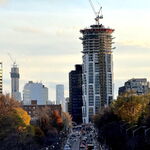The decision to start Niagara 4 years early was highly political.
I have hugely mixed feelings about that because many optimizations are needed first before Niagara is way more practical.
I think we need more upgraded buses in the interim, too.
That said, Niagara GO is here to stay for better or for worse -- I've seen quite a
lot of construction south of Lake Ontario (kind of a spiritual sequel to
my old 2015 article). Helping Niagara's long-term business case recently is the
major increase of West Harbour GO ridership (~10x increase), and there's some
potential acceleration to Beamsville GO (Town of Lincoln) -- but many optimizations are needed between Aldershot and Niagara Falls to reduce the 2.5h ride to about 1.5h which is technically possible within a decade.
West Harbour in 2015 was as dead as Niagara Falls GO in 2019 at often less than a dozen boarding many trains.
But now
with over 100 on some West Harbour GO trains [VIDEO] -- lots has changed in 4 years. The GO Expansion Business case (Page 45) shows hourly diesel semiexpresses that skips most stations between Burlington-Union to Hamilton. And also, new track is masterplanned all the way from West Harbour to Lewis Yard. GO trains would be able to go at a very good clip (80mph) along upgraded sections in the CP corridor. Not quite as fast as the 90mph on express parts of Lakeshore West.
Not to mention, the need to stop
all Niagara trains in Hamilton, is a
longtime bone of contention -- Now that the weekend service is permanent, over 400 weekend Niagara trains per year pass Hamilton without stopping, because West Harbour is still a dead-end station. Hamilton has a bigger population than many stations along the Stoufville line, so I really think 100% of all Niagara trains deserve to stop in Hamilton. More people are on Niagara weekend trains than are on the Stoufville weekend trains, although the inverse seems true for weekdays (more people on weekday Stoufville trains than weekday Niagara trains).
With the new weekday trains (backing in and out of West Harbour) -- which really slows down the weekday Niagara trains. Skipping the backin-backout step would save 15 minutes off the 2.5 hour time alone -- not to mention the other optimizations
Combined optimizations but it would dramatically cut time both north & south of Lake Ontario.
-- Express Union-to-Burlington operation (except for stops in Oakville); as seen on Page 45 of 2018 GO Expansion Business Case.
-- Elimination of backin-backout at West Harbour; an inefficiency occuring today.
-- Rail speed upgrade south of Lake Ontario thanks to new Metrolinx-funded parallel tracks in CP corridor; buildout is reportedly to begin in 2020 extending the dead-end tracks at West Harbour and slowly incrementally builds outwards towards Lewis and probably eventually beyond.
Combined, this will turn a 2.5h commute to an easily sub-2h commute, while also providing the Hamilton-Niagara commute option that's faster than driving Hamilton-Niagara. Toronto-Hamilton can be a sub-hour trip, and Hamilton-Niagara can be a sub-hour trip. Not quite as fast as the
47-minute Union-Hamilton GO train I once was on, but potentially sub-1hr accounting for a few stops. That makes it faster than freeways most of the time. That invite quite a ridership increase.
Such optimizations -- once complete -- would skyrocket StCat / Niagara ridership.
This may take many years (more than 4 years) to complete the necessary optimizations to build the ridership and StCat is where more ridership occurs than Niagara Falls. I suspect that StCat will eventually be future allday 2way terminus once the service is fast enough (1.5h to Toronto, with convenient stops in Hamilton). With Niagara Falls remaining a peak-only terminal.
The problem is that starting the GO train services has sometimes been used to scale back the GO bus service (like what happened to Stoufville). I fear the same might have already happened to Niagara, now that still-highly-unoptimized trains runs 365 days a year from Niagara Falls.
But there is no turning back the clock -- Metrolinx certainly appears 100% commited to upgrading Niagara, and what is recently happening to West Harbour ridership pretty much very well may vindicate the decision to stay the Niagara Falls path --
eventually.




